Dell U3011 Review: Dell's New 30-inch Flagship
by Brian Klug on January 13, 2011 9:17 PM ESTViewing Angles
The U3011 has superb viewing angles, just like we've grown accustomed to seeing from IPS panels. Even at the far extreme horizontally, there's none of the purple I'm used to seeing from TN panels as you move off-axis. In the vertical direction, I saw the same thing with almost nothing to complain about. I did notice some glare at the extreme angles, but again that's dependent on where you're sitting and where light sources are located.
I think this is an excellent opportunity to talk about IPS graininess, something we really haven't discussed before. Of the IPS panels I've used to date, all of them have had some high frequency grain on the surface from a combination of coating and interference at the interface. Thankfully the U3011 has a combination antireflection coating and hard coating, and subjectively there seems to be less grain than I've seen on other displays.
Color Quality
Next up are the ever-important color quality metrics. As usual, we report two main quality metrics: color accuracy (Delta-E) and color gamut. Color gamut refers to the range of colors the display is able to represent with respect to some color space. In this case, our reference is the AdobeRGB 1998 color space, which is larger than the sRGB color space. Our percentages are thus reported with respect to AdobeRGB 1998, and larger is generally better unless you're dealing with sRGB content and colorspace-unaware software.
Color accuracy (Delta E) refers to the display’s ability to display the correct color requested by the GPU and OS. The difference between the color represented by the display, and the color requested by the GPU is our Delta-E, and lower is better here. In practice, a Delta E under 1.0 is perfect - the chromatic sensitivity of the human eye is not great enough to distinguish a difference. Moving up, a Delta E of 2.0 or less is generally considered fit for use in a professional imaging environment - it isn’t perfect, but it’s hard to gauge the difference. Finally, Delta E of 4.0 and above is considered visible with the human eye. Of course, the big consideration here is frame of reference; unless you have another monitor or some print samples like a Gretag Macbeth color checker card to compare your display with, you might not notice.
As I mentioned in our earlier reviews, we’ve updated our display test bench. We’ve deprecated the Monaco Optix XR Pro colorimeter in favor of an Xrite i1D2 since there are no longer up-to-date drivers for modern platforms. We're trying to find an i1Pro to use as well.
For these tests, we calibrate the display and try to obtain the best Delta-E we can get at both 200 nits of brightness for normal use, and 100 nits for print brightness. We target D65 and a gamma of 2.2, but sometimes the best performance lies at native temperature and another gamma, so we try to find what absolute absolute best-case performance for each display. We also take an uncalibrated measurement to show performance out of the box using either the manufacturer supplied color profile, or a generic one with no LUT data. For all of these, dynamic contrast is disabled, and displays are left to settle for a half hour after making changes. The U3011 is CCFL-backlit, and I used a settle time of 30 minutes accordingly.
First up is uncalibrated Delta-E performance. For this test, I took the monitor out of the box, connected it over DisplayPort, adjusted to 200 nits, and ran our usual GMB color checker test. Results aren't that great, sadly.
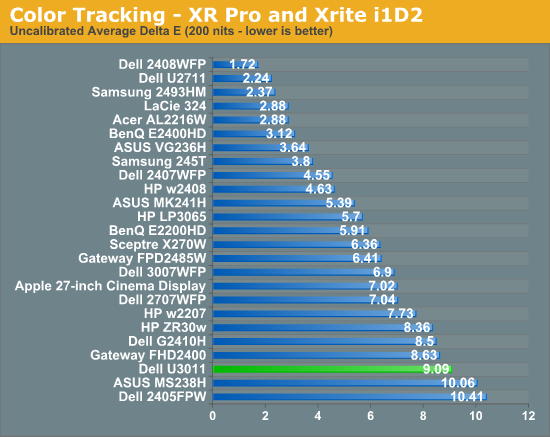
I mentioned earlier that the U3011 we got from Dell for testing came with no factory calibration report. After checking up with them, we learned this is a pre-production unit identical to what's shipping now, minus that factory calibration. That's something we can live with, especially since we recommend every display be calibrated, but still unnerving.
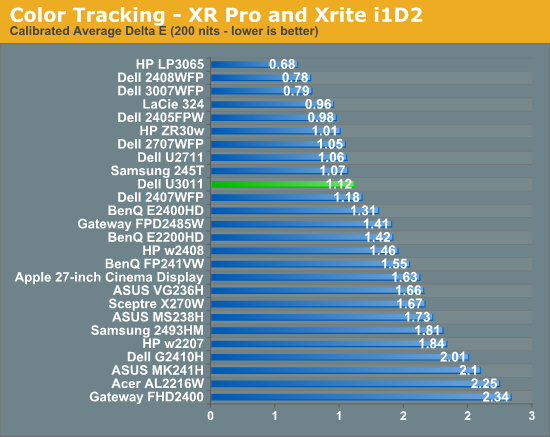
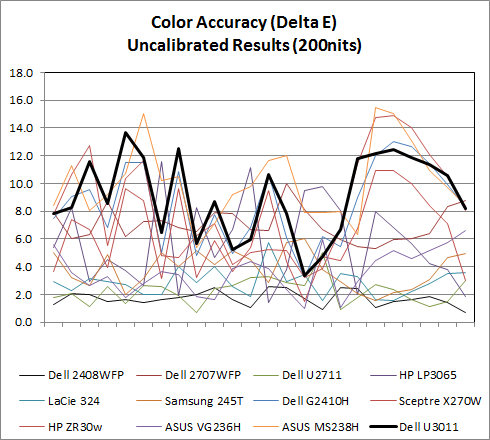
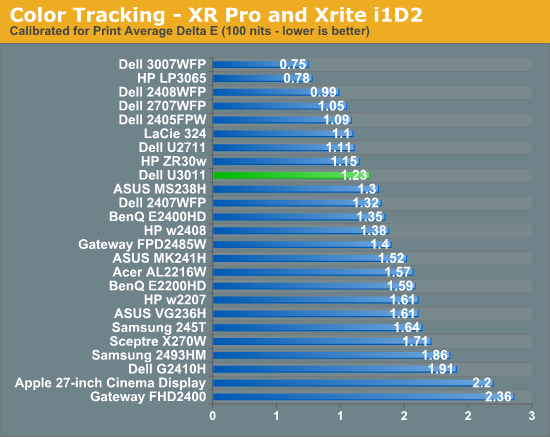
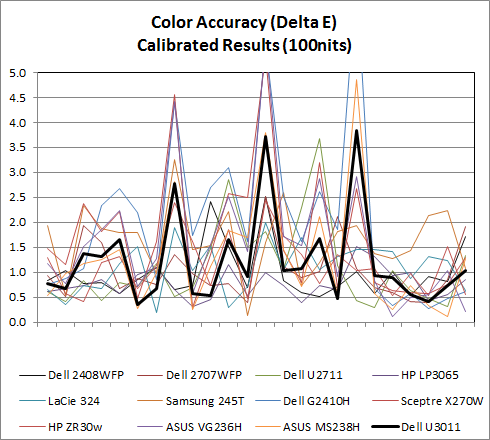
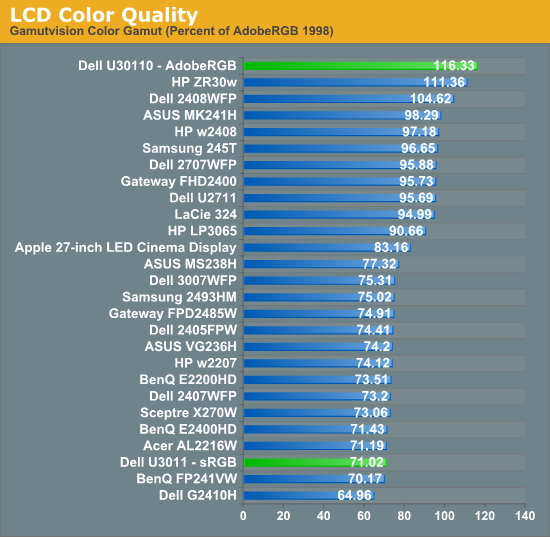

AdobeRGB Mode
sRGB Mode
Calibrated Delta-E is very good, though I'm still surprised the U3011 can't get under 1.0 on our tests. I'm starting to suspect that our i1D2 isn't quite as good as the Monaco Optix XR Pro, and have started looking for an i1Pro spectroradiometer as a result so we can have something more accurate going forward. That said, performance is still more than adequate for professional work. These two calibrations were performed in the sRGB mode at D65.
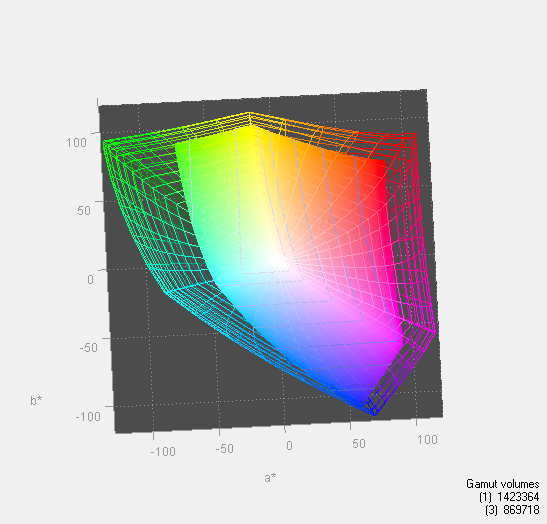
In addition, the U3011 has modes for AdobeRGB color space and sRGB in the OSD, something extremely useful for doing work and not getting oversaturation in applications that lack color management. You can immediately see the effect of those two modes in the color gamut measure above. Letting the monitor free to use its entire gamut of color, it leads the pack. Turn sRGB mode on, and it clamps down just nicely. 116.33% is also shockingly close to Dell's advertised 117% coverage of CIE 1796 (AdobeRGB), which is awesome to see confirmed above.








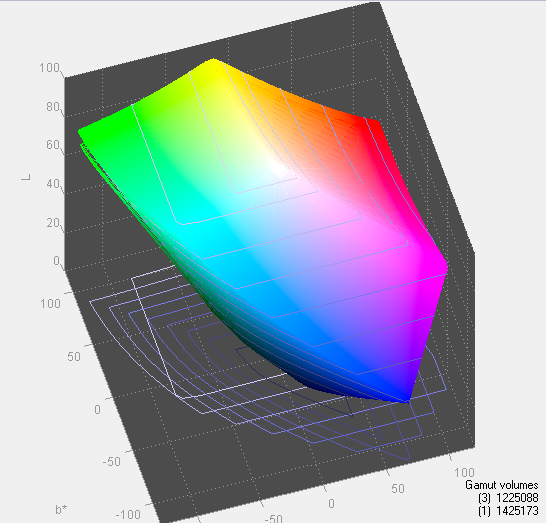
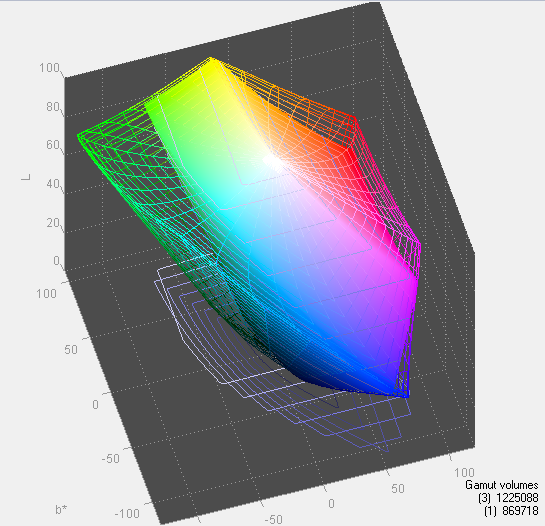








123 Comments
View All Comments
MeanBruce - Friday, January 14, 2011 - link
When is Dell going to start offering LED backlighting for it's UltraSharp lineup? 24" 27" and 30" We are waiting!cjl - Friday, January 14, 2011 - link
The thing is, WLED backlighting is actually worse image quality than CCFL, and RGBLED is both expensive and still has problems with lifetime. All the lower end monitors love to advertise LED because it sounds great and new, and it's definitely the way to go if your goal is low power consumption and heat. However, for the absolute best display quality, CCFL is the way to go (unless you go to the insanely expensive RGBLED screens).Pessimism - Friday, January 14, 2011 - link
CCFL=FAIL.Have you placed a year old CCFL-Based laptop next to a brand new one? You'll see a large drop in brightness and a noticeable yellowing of the picture. The manufacturers use the cheapest CCFL tubes humanly possible with short-lived phosphors. Additionally they make them near impossible to access to replace, when they could easily place them behind a removable panel with a quick disconnect connector to replace them.
I'll take my chances with LED.
ClownPuncher - Friday, January 14, 2011 - link
We aren't talking about laptop backlighting here.cjl - Friday, January 14, 2011 - link
Yes, laptops use short-lived, cheap CCFLs. This isn't a laptop. High end IPS monitors use high end, wide gamut CCFL backlighting which is much better quality than any laptop backlighting (and also more power hungry, which is one of the reasons it's not good for laptops). Have you ever seen a high end CCFL backlit monitor? They absolutely blow away WLED (which is what the vast majority of LED screens use). RGBLED would be nice, but as I said before, it's both quite expensive and it still has a few unresolved issues.semo - Friday, January 14, 2011 - link
Yeah would have been nice to see RGB back lighting on the latest, greatest and most advanced display of a company's lineup. This thing won't be replaced for the next 3 years at least I would imagine.Anyway, I would prefer 3x 24" monitors instead of one or two 30" if I had the money to burn.
DanNeely - Friday, January 14, 2011 - link
I have a 30" and 2 20" 1200x1600 panels on my main system now (all bought before eyefinity was an option). I don't think I could ever go back to a smaller main screen. I makes my 22 (1680x1050) and 19" (1280x1024) combo at work frustrating to use at times. For everything except eyefinity gaming I'd recommend one 30 over 2 smaller screens; and I suspect most people who can afford a 30 will also have at least one additional monitor hooked up.DanNeely - Sunday, January 16, 2011 - link
The replacement time probably will depend on when a significantly better panel becomes available. The 3007 was followed by the 3008 when a wide gamut panel was available. Nothing major changed on the next few years, so Dell didn't do a refresh until this year. And at least on paper the only thing that really changed was the addition of 10bit color, and the addition of a 2nd HDMI port in place of several legacy connections; I suspect this refresh had more to do with 08 looking like an obsolete model year than anything else.An RGBLED backlight that lasted long enough and that didn't break the bank would be grounds for a major update. A USB3 hub or Lightpeak support could trigger another minor refresh next year. If the memory card reader only supports SDHC an SDXC update could trigger a new minor revision as well.
ZoSo - Friday, January 14, 2011 - link
I'm still debating myself with getting the U3011 or ZR30w, reason being I do game often.But lately photo and video editing has been in the picture more and more. And of course I'd be watching movies too ;)
Decisions, decisions, it's a love hate thing,,, lol
bigboxes - Friday, January 14, 2011 - link
Thanks Brian. I was just about to comment on the lack of NEC models in your comparison charts. I know I will be upgrading soon and a monitor is so important. I spend so many hours a day staring at this device that it makes all the difference when you have a high-quality display.